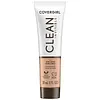What's inside
What's inside
 Key Ingredients
Key Ingredients

 Benefits
Benefits

 Concerns
Concerns

 Ingredients Side-by-side
Ingredients Side-by-side

Water
Skin ConditioningDiethylhexyl Succinate
EmollientUndecane
EmollientPhenyl Trimethicone
Skin ConditioningTrimethylolpropane Triisostearate
EmollientIsododecane
EmollientPropanediol
SolventTridecane
PerfumingAlumina
AbrasiveIsononyl Isononanoate
EmollientTrimethylsiloxyphenyl Dimethicone
Cetyl PEG/PPG-10/1 Dimethicone
EmulsifyingPEG-150
HumectantTrimethylsiloxysilicate
EmollientPolyglyceryl-4 Isostearate
EmulsifyingC12-15 Alkyl Lactate
EmollientEthyl Benzoate
PerfumingDisteardimonium Hectorite
StabilisingSodium Chloride
MaskingAluminum Hydroxide
EmollientCI 77120
Cosmetic Colorant1,2-Hexanediol
Skin ConditioningCaprylyl Glycol
EmollientParfum
MaskingSodium Lauroyl Glutamate
Helianthus Annuus Seed Oil
EmollientDisodium EDTA
Rosmarinus Officinalis Leaf Extract
AntimicrobialRosa Rugosa Leaf Extract
HumectantLysine
Skin ConditioningLactobacillus
Skin ConditioningPrunus Cerasus Fruit Extract
AntioxidantMagnesium Chloride
Xanthan Gum
EmulsifyingTropolone
Skin ConditioningPalmitic Acid
EmollientTocopherol
AntioxidantMagnesium Hydroxide
AbsorbentCI 77492
Cosmetic ColorantCI 77891
Cosmetic ColorantCI 77491
Cosmetic ColorantCI 77499
Cosmetic ColorantWater, Diethylhexyl Succinate, Undecane, Phenyl Trimethicone, Trimethylolpropane Triisostearate, Isododecane, Propanediol, Tridecane, Alumina, Isononyl Isononanoate, Trimethylsiloxyphenyl Dimethicone, Cetyl PEG/PPG-10/1 Dimethicone, PEG-150, Trimethylsiloxysilicate, Polyglyceryl-4 Isostearate, C12-15 Alkyl Lactate, Ethyl Benzoate, Disteardimonium Hectorite, Sodium Chloride, Aluminum Hydroxide, CI 77120, 1,2-Hexanediol, Caprylyl Glycol, Parfum, Sodium Lauroyl Glutamate, Helianthus Annuus Seed Oil, Disodium EDTA, Rosmarinus Officinalis Leaf Extract, Rosa Rugosa Leaf Extract, Lysine, Lactobacillus, Prunus Cerasus Fruit Extract, Magnesium Chloride, Xanthan Gum, Tropolone, Palmitic Acid, Tocopherol, Magnesium Hydroxide, CI 77492, CI 77891, CI 77491, CI 77499
Water
Skin ConditioningDimethicone
EmollientPropylene Glycol
HumectantCaprylyl Methicone
Skin ConditioningDicaprylyl Ether
EmollientCetyl PEG/PPG-10/1 Dimethicone
EmulsifyingSilica
AbrasivePEG-10 Dimethicone
Skin ConditioningSodium Chloride
MaskingDisteardimonium Hectorite
StabilisingTribehenin
EmollientGlycerin
HumectantPhenoxyethanol
PreservativeTocopheryl Acetate
AntioxidantTriethyl Citrate
MaskingChlorphenesin
AntimicrobialMethicone
EmollientAlumina
AbrasivePropylene Carbonate
SolventTocopherol
AntioxidantPentaerythrityl Tetra-Di-T-Butyl Hydroxyhydrocinnamate
AntioxidantCI 77891
Cosmetic ColorantMica
Cosmetic ColorantIron Oxides
Water, Dimethicone, Propylene Glycol, Caprylyl Methicone, Dicaprylyl Ether, Cetyl PEG/PPG-10/1 Dimethicone, Silica, PEG-10 Dimethicone, Sodium Chloride, Disteardimonium Hectorite, Tribehenin, Glycerin, Phenoxyethanol, Tocopheryl Acetate, Triethyl Citrate, Chlorphenesin, Methicone, Alumina, Propylene Carbonate, Tocopherol, Pentaerythrityl Tetra-Di-T-Butyl Hydroxyhydrocinnamate, CI 77891, Mica, Iron Oxides
Ingredients Explained
These ingredients are found in both products.
Ingredients higher up in an ingredient list are typically present in a larger amount.
Alumina is another name for the compound aluminum oxide. It is used as a thickener, absorbent, and abrasive.
As an absorbent, alumina can give a mattifying effect. It is used in mineral sunscreens to help coat nano-sized filters, such as titanium dioxide. By increasing the size of the UV filters, these ingredients stay on the skin for a longer time. By coating small sized ingredients, alumina helps thicken a product.
Alumina may be used as an abrasive, or exfoliant.
Alumina is naturally occurring in the mineral corundum. Certain varieties of corundum create rubies and sapphires. Corundum is also the crystalline form of alumina.
Learn more about AluminaThis ingredient is a high molecular weight silicone. It has emulsifying and skin conditioning properties.
Ci 77891 is a white pigment from Titanium dioxide. It is naturally found in minerals such as rutile and ilmenite.
It's main function is to add a white color to cosmetics. It can also be mixed with other colors to create different shades.
Ci 77891 is commonly found in sunscreens due to its ability to block UV rays.
Learn more about CI 77891Disteardimonium Hectorite comes from the clay mineral named hectorite. It is used to add thickness to a product.
It can also help stabilize a product by helping to disperse other ingredients.
Hectorite is a rare, white clay mineral.
Learn more about Disteardimonium HectoriteChances are, you eat sodium chloride every day. Sodium Chloride is also known as table salt.
This ingredient has many purposes in skincare: thickener, emulsifier, and exfoliator.
You'll most likely find this ingredient in cleansers where it is used to create a gel-like texture. As an emulsifier, it also prevents ingredients from separating.
There is much debate on whether this ingredient is comedogenic. The short answer - comedogenic ratings don't tell the whole story. Learn more about comegodenic ratings here.
The concensus about this ingredient causing acne seems to be divided. Research is needed to understand if this ingredient does cause acne.
Scrubs may use salt as the primary exfoliating ingredient.
Learn more about Sodium ChlorideTocopherol (also known as Vitamin E) is a common antioxidant used to help protect the skin from free-radicals and strengthen the skin barrier. It's also fat soluble - this means our skin is great at absorbing it.
Vitamin E also helps keep your natural skin lipids healthy. Your lipid skin barrier naturally consists of lipids, ceramides, and fatty acids. Vitamin E offers extra protection for your skin’s lipid barrier, keeping your skin healthy and nourished.
Another benefit is a bit of UV protection. Vitamin E helps reduce the damage caused by UVB rays. (It should not replace your sunscreen). Combining it with Vitamin C can decrease sunburned cells and hyperpigmentation after UV exposure.
You might have noticed Vitamin E + C often paired together. This is because it is great at stabilizing Vitamin C. Using the two together helps increase the effectiveness of both ingredients.
There are often claims that Vitamin E can reduce/prevent scarring, but these claims haven't been confirmed by scientific research.
Learn more about TocopherolWater. It's the most common cosmetic ingredient of all. You'll usually see it at the top of ingredient lists, meaning that it makes up the largest part of the product.
So why is it so popular? Water most often acts as a solvent - this means that it helps dissolve other ingredients into the formulation.
You'll also recognize water as that liquid we all need to stay alive. If you see this, drink a glass of water. Stay hydrated!
Learn more about Water